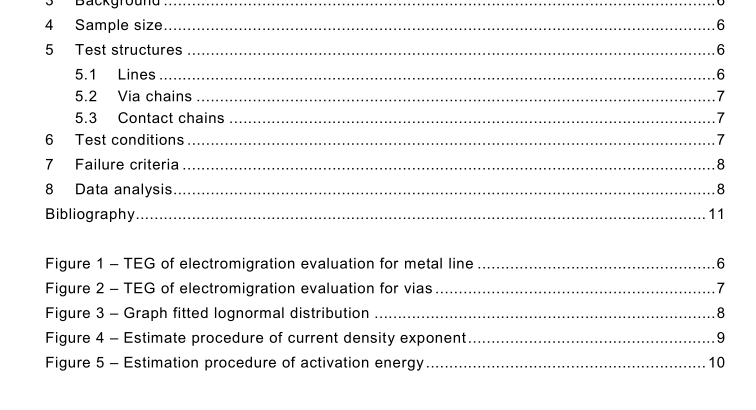IEC 62415:2010 pdf download – Semiconductor devices – Constant current electromigration test
1 Scope
This standard describes a method for conventional constant current electromigration testing of metal lines, via string and contacts.
2 Symbols, terms and definitions
For the purposes of this document, the following symbols, terms and definitions apply:
2.1 Symbols
2.1.1
J via_use
the maximum current density permitted to flow in a via of a real product
2.1.2
J line_use
the maximum current density permitted to flow in a line of a real product
2.1.3
J via_test
the current density in a via of a test structure during electromigration test
2.1.4
J line_test
the current density in a line of a test structure during electromigration test
2.1 .5
t(x %)
time to failure of x % of the population
NOTE The method for calculation of t (50 %) is described in Clause 8.
2.2 Terms and definitions
2.2.1
TEG
test element group. This is the test structure used for the test
2.2.2
Blech length
the line length below which electromigration time to failure increases sharply [1 ] 1
NOTE The drift of metal atoms causes stress build-up in the metal lines, which caused a back flow of atoms.
For short lines the stress gradient is higher than for long lines with the same current density. The forward flow increases more rapidly with current density than the backflow, and consequently the Blech length is inversely proportional to the current density. The Blech length can be determined by using a chain with different line lengths between the vias.
3 Background The background of electromigration testing as described in this procedure is based on the assumption that the entire electromigration failure time distribution stays intact when accelerated. Acceleration can be described by an activation energy and a current acceleration factor, as originally proposed by Black [2].
4 Sample size 1 5 samples or more are recommended for each test (each test structure, temperature and current density). In some cases, to get a better statistical confidence of the results or to analyze a bimodal distribution, a higher number of samples might be necessary.
5 Test structures
5.1 Lines Electromigration characterization shall be carried out on fully back-end processed samples. The metal line test structure in a 4-terminal (Kelvin) configuration shall be used (see Figure 1 a).The line length is recommended to be at least 800 μm. The use of monitors for opens, inter-layer shorts and optional intra-layer shorts is recommended (see Figure 1 b).The line length is determined by the constraints that short lines are not sensitive to failure and exhibit the Blech effect [1 ], and too long lines require high voltages. For line lengths <200 μm the Blech effect shall be verified. The line width shall be process-dependent. Narrow lines carry higher current densities and are more susceptible to electromigration failure. On the other hand, lines with width smaller than the grain size may have longer lifetime than wider lines due to the bamboo effect [3]. Therefore, lines with the minimum design rule width or the line width that gives the shortest life time (e.g. wide lines with width greater than the grain size, that are more representative of the current carrying lines in the circuit) shall be used in the test. Other line widths may be added if necessary. Metal lines of each layer, both over a flat surface as well as over topography (only for processes without planarized back-end), should be used.
5.2 Via chains This is a chain of vias between metal layers connected in series. The via chain test structure shall contain at least 1 0 vias (see Figure 2). As an option, test structures may be used where the contacts between metal layers are formed by a number of vias in parallel. IEC 62415 pdf download.
